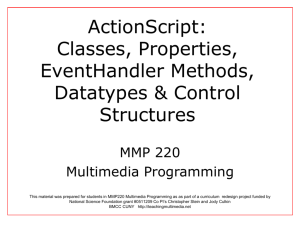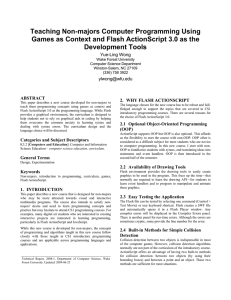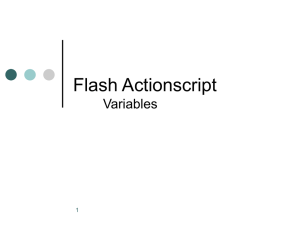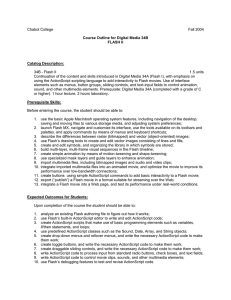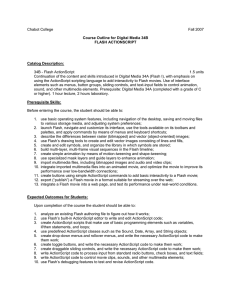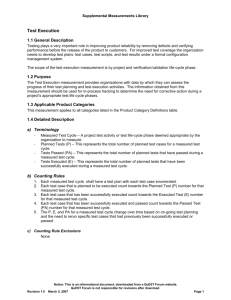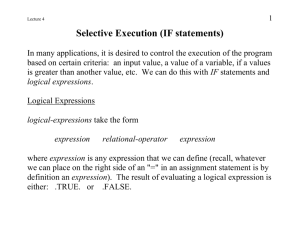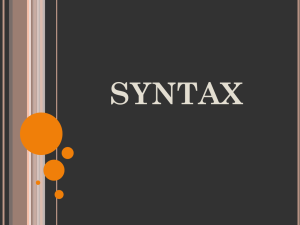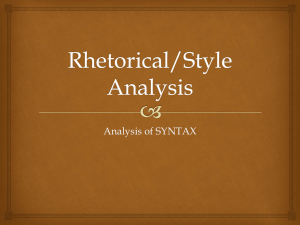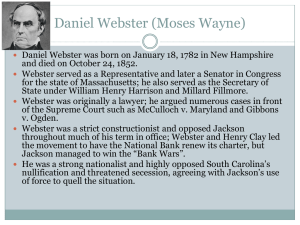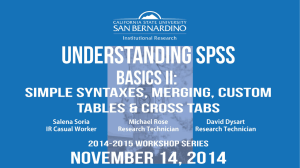Chapter 9 Interactive Multimedia Authoring with Flash: ActionScript
advertisement
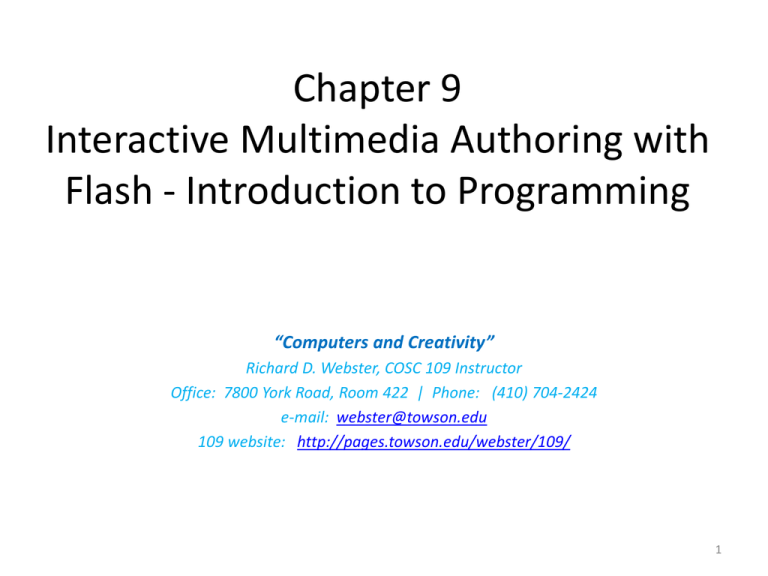
Chapter 9
Interactive Multimedia Authoring with
Flash - Introduction to Programming
“Computers and Creativity”
Richard D. Webster, COSC 109 Instructor
Office: 7800 York Road, Room 422 | Phone: (410) 704-2424
e-mail: webster@towson.edu
109 website: http://pages.towson.edu/webster/109/
1
Some Common Terms
• Writing code
– means entering the code
– is part of the process of creating the computer
program
• Running code, executing code
– refers to the process by which the computer carries
out the instructions in a computer program
• Compiling
– refers to the process of assembling code into a format
suitable for the computer to execute the instructions
2
More Common Terms
• Computer Programming Languages
– are for writing instructions that can be followed by
a computer
• IDE
– stands for:
Integrated Development Environment
– refers to:
• the software in which you are developing an
application
• for example, Adobe Flash, Microsoft Visual Studio
3
Programming Languages
Multimedia authoring scripting languages, such as Flash Actionscript and
Director Lingo are often the highest level.
high level
Programming languages that look more like human language.
Easy for human to read and write, but require more "translation"
behind the scenes to be understandable to the computer.
e.g. C++, Java, FORTRAN
Assembly language
low level
lowest level:
Machine language: a programming language that
communicates with a computer through 0's and 1's
4
Scripting Languages
• Examples: Flash ActionScript, Director Lingo, Javascript
• Very-high-level programming languages
• Advantage: easier for non-programmer to learn because the
syntax and keywords are close to human languages
• Disadvantages:
– Not as full-fledged as programming languages such as C++,
Java, and FORTRAN
– Don't have the features to let the programmer to control
low level details, such as memory allocation
5
Flash Actionscript
• a scripting language
• getting full-fledged
• based on the same standard as Javascript
• Actionscript 1.0, 2.0, 3.0
Easiest to learn.
Has stricter rules than 1.0.
The newest version of ActionScript.
More difficult than the other two
versions.
This is what we will be using in this
course.
6
Syntax
• prescribes the ways in which statements must be written in
order for them to be understood by the computer
• like the rules of grammar and punctuation in human
languages, but these rules must be followed precisely in
computer programming
• for examples, for ActionScript:
– case sensitive
– each statement ends with a semi-colon(;)
– the naming of variables and functions has to start with a letter ,
_ or $
7
Variables
• Purpose:
to store values that can be updated and
retrieved at runtime
• Data is stored in memory as bits.
• Variable lets you refer, by name, to the data's
memory location stored.
8
Variable Naming
• can contain a number, a letter, underscore (_), or
dollar sign ($)
• cannot begin with a number
• in this course, variables always begin with a letter
• cannot be a keyword
• look up Actionscript 3.0 Language Reference in
Help for all the keywords
• If the word turns blue in your code window, it
means it is a keyword.
9
Case Sensitivity of Variable Names
• score and Score are different
• number and nuMBer are different
10
Assigning a Value to a Variable
• Means giving a value to a variable
• The statement that assigns a value to a
variable is called an assignment statement.
11
Assigning a Value to a Variable
General Syntax:
variableName = value or
expression;
Examples:
score = 10;
letterGrade = "A";
sum = a + b;
12
Declaring a Variable
• Before you use a variable or assigning a value
to a variable, you need to declare the variable.
• General Syntax:
Two ways to declare a variable:
– Declare without assigning a value:
var variableName:dataType;
– Declare and assign a value:
var variableName:dataType = value
or expression;
13
Declaring a Variable
Examples:
var score:int;
var score:int = 0;
14
Data Types
Basic Data Types in Actionscript
int
uint
Number
String
Boolean
MovieClip
Object
Null
void
15
How a Program Runs
• A program is written as a sequence of
statements as instructions.
• The program executes the instructions
sequentially--one instruction after the other,
in the order in which they appear in the code.
• Use control structures to make nonsequential
execution of the instructions.
16
Types of Control Structures
• Loop
– A set of statements is executed repeatedly until a
certain condition is reached
– Will be covered in Chapter 11
• Conditional
– A set of statements is executed only if some
conditions are met
– if statements and switch statements
17
if Statements
•
•
•
•
if
if...else
if...else if
Nested if statements
18
if
General Syntax:
if (logical expression(s))
{
statement(s)
}
The statements grouped within the curly
braces are called the block statements.
19
if
Example:
if (score > 600)
{
grade = "pass";
}
20
if
• If there is only one statement to be executed,
the curly braces are optional.
• Examples:
if (score > 60)
grade = "pass";
The statement may be on a single line:
if (score > 60) grade = "pass";
21
If statements and looping
• Both if statements and Loops can be used to
make a program execute nonsequentially.
22
if...else
General Syntax:
if (logical expression(s))
{
statement(s)
}
else
{
statement(s)
}
23
if...else
Example:
if (score > 60)
{
grade = "pass";
}
else
{
grade = "fail";
}
24
if...else if
General Syntax:
if (logical expression(s))
{
statement(s)
}
else if (logical expression(s))
{
statement(s)
}
...
else if (logical expression(s))
{
statement(s)
}
else
{
statement(s)
}
25
if...else if
Example:
if (score > 90)
{
grade = "A";
}
else if (score > 80)
{
grade = "B";
}
else if (score > 70)
{
grade = "C";
}
else if (score > 60)
{
grade = "D";
}
else
{
grade = "F";
}
26
if...else if
• The conditions are checked one at a time
sequentially.
• Once a condition is found to be true, the
statement(s) for that condition will be
executed and the rest of the conditions in the
if . . . else if statements group
will not be checked.
27
if...else if
Example:
if (score > 90)
{
grade = "A";
}
else if (score > 80)
{
grade = "B";
}
else if (score > 70)
{
grade = "C";
}
else if (score > 60)
{
grade = "D";
}
else
{
grade = "F";
}
Suppose score = 85.
28
if...else if
Example:
if (score > 90)
{
grade = "A";
}
else if (score > 80)
{
grade = "B";
}
else if (score > 70)
{
grade = "C";
}
else if (score > 60)
{
grade = "D";
}
else
{
grade = "F";
}
Suppose score = 85.
First check: (score > 90).
(85 > 90) is false!
29
Logical Operators
&& AND
|| OR
! NOT
30
Logical AND: &&
logicalExpression1 && logicalExpression2
true : only when both logicalExpression1 and
logicalExpression2 are true
false : when either logicalExpression1 or
logicalExpression2 is false
31
Logical OR: ||
logicalExpression1 || logicalExpression2
true : when either logicalExpression1 or
logicalExpression2 is true
false : only when both logicalExpression1 and
logicalExpression2 is false
32
Logical NOT: !
!logicalExpression1
true : when logicalExpression1 is false
false : when logicalExpression1 is true
33
Examples
Example 1
if (age < 40 &&
weight < 150)
{
group = 2;
}
else
{
group = 3;
}
Example 2
if (age < 40 ||
weight < 150)
{
group = 2;
}
else
{
group = 3;
}
Which statement will be executed in these examples
when age = 38 and weight = 145?
34
Examples
Example 1
if (age < 40 &&
weight < 150)
{
group = 2;
}
else
{
group = 3;
}
Example 2
if (age < 40 ||
weight < 150)
{
group = 2;
}
else
{
group = 3;
}
Which statement will be executed in these examples
when age = 38 and weight = 157?
35
Examples
Example 1
if (age < 40 &&
weight < 150)
{
group = 2;
}
else
{
group = 3;
}
Example 2
if (age < 40 ||
weight < 150)
{
group = 2;
}
else
{
group = 3;
}
Which statement will be executed in these examples
when age = 46 and weight = 145?
36
Examples
Example 1
if (age < 40 &&
weight < 150)
{
group = 2;
}
else
{
group = 3;
}
Example 2
if (age < 40 ||
weight < 150)
{
group = 2;
}
else
{
group = 3;
}
Which statement will be executed in these examples
when age = 46 and weight = 157?
37
Examples
Sum = addTogether(2,5);
By examining the statement above you should
be able to infer that addTogether()
Returns a value, and, Takes arguments
38
functions and procedures
(see text pages 305-307)
• function: block of code that forms a discrete
unit with a name;
• Procedure: very similar to functions, excerpt
that they do not return values. Otherwise,
both functions and procedures can take
paremeters.
39

